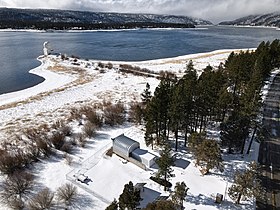Synoptic Optical Long-term Investigations of the Sun
This article needs additional citations for verification. (October 2020) |
 SOLIS instruments at the National Solar Observatory (NSO)at Kitt Peak | |
| Location(s) | Big Bear Solar Observatory, California |
|---|---|
| Coordinates | 34°15′38″N 116°55′15″W / 34.260547°N 116.920920°W |
| Organization | NSO Integrated Synoptic Program (NISP) |
| Altitude | 2063.1 m |
| Built | 2003 |
| Website | solis |
| | |
Synoptic Optical Long-term Investigations of the Sun (SOLIS) is a synoptic facility for solar observations over a long time frame that is funded by the National Science Foundation (NSF) and designed and built by the National Solar Observatory (NSO).[1][2][3] It is operated by the NSO Integrated Synoptic Program (NISP). SOLIS is a single set of three instruments mounted on a common observing platform. The instruments are the 50 cm aperture Vector Spectromagnetograph (VSM), the 8 mm aperture Integrated Sunlight Spectrometer (ISS), and the 14 cm aperture Full-Disk Patrol (FDP). The VSM telescope is a quasi-Ritchey-Chretien design with a primary mirror operating at f/1.6. The ~ 400 W of solar light from the primary is reflected by a secondary mirror fabricated from a single silicon crystal. The final f/6.6 full-disk solar image is focused on a spectrograph slit that is cooled by a flow of chilled water-propylene glycol solution. The mirrors are coated with protected silver. To improve the internal seeing, the VSM is sealed by 74 cm diameter, 6 mm thick fused silica window. Originally, it was filled with helium at about ambient pressure and temperature.[4] In 2014, helium was replaced by nitrogen due to the increasing cost of helium. Due to this change, the image sharpness was slightly degraded.[5]
The VSM provides full-disk vector (strength and direction) maps of the solar magnetic field both in the photosphere and in the chromosphere on a daily basis, continuing the 40-year record of NSO magnetic field observations. The ISS obtains spectra of the Sun integrated over the solar disk, so the Sun appears as it would as a much more distant star. The combination of data from the ISS and the VSM is useful for studies of exoplanet systems as it allows the modeling of the influence of a star's magnetic field on its spectrum giving clues to the activity level that the exoplanets may be subject to. The FDP provides full-disk images of the Sun in a variety of spectral lines with a cadence as high as 10 seconds.
SOLIS was located on top of the Vacuum Telescope building[6] at Kitt Peak National Observatory until July 2014,[7] then temporarily moved to the University of Arizona Agricultural Farm in Tucson until October 2017, and is now being permanently relocated to Big Bear Solar Observatory in California.[8][9][10] Once back to operations, SOLIS will provide unique observations of the Sun on a continuing basis for several decades to understand the solar activity cycle, sudden energy releases in the solar atmosphere, and solar irradiance changes and their relationship to global change.
SOLIS Gallery[edit]
-
Crews pour concrete footings, the first step in the construction of a permanent home of the NSF’s SOLIS instrument at Big Bear Solar Observatory in California
-
SOLIS on the shore of Big Bear Lake, California. White dome in the background is the Goode Solar Telescope
-
SOLIS mount installation looking down
-
The vector spectromagnetograph mounted on top of the Kitt Peak Synoptic Optical Long-term Investigations of the Sun (SOLIS) Tower, formerly the vacuum telescope tower.
See also[edit]
References[edit]
- ^ Keller, C. U.; Harvey, J. W.; Giampapa, M. S. (2003). Keil, Stephen L; Avakyan, Sergey V (eds.). "SOLIS: an innovative suite of synoptic instruments". Proceedings of the SPIE. Innovative Telescopes and Instrumentation for Solar Astrophysics. 4853: 194–204. Bibcode:2003SPIE.4853..194K. doi:10.1117/12.460373. S2CID 121871549.
- ^ Balasubramaniam, K. S.; Pevtsov, A. A. (2011). Fineschi, Silvano; Fennelly, Judy (eds.). "Ground-based synoptic instrumentation for solar observations". Proceedings of the SPIE. Solar Physics and Space Weather Instrumentation IV. 8148: 194–204. Bibcode:2011SPIE.8148E..09B. doi:10.1117/12.892824. S2CID 123569040.
- ^ National Research Council; Division on Engineering and Physical Sciences; Space Studies Board; Committee on Solar and Space Physics; Solar and Space Physics Survey Committee (17 December 2003). The Sun to the Earth - and Beyond: Panel Reports. National Academies Press. p. 26. ISBN 978-0-309-08972-2.
- ^ Engvold, Oddbjorn; Vial, Jean-Claude; Skumanich, Andrew (15 November 2018). The Sun as a Guide to Stellar Physics. Elsevier. p. 422. ISBN 978-0-12-814335-3.
- ^ Harvey, J. W. (2014). "Image Quality of SOLIS/VSM in Helium vs. Nitrogen". NSO Technical Report. NSO/NISP-2014-01: 1–10. arXiv:1405.7967.
- ^ Leverington, David (2017). Observatories and telescopes of modern times : ground-based optical and radio astronomy facilities since 1945. New York: Cambridge University Press. p. 34. ISBN 978-0-521-89993-2. Retrieved 25 February 2023.
- ^ Beal, Tom (2017-05-12). "Sun setting on solar telescope at Kitt Peak, southwest of Tucson". Arizona Daily Star. Retrieved 2020-10-19.
- ^ "A new telescope expands Big Bear Solar Observatory's view of the Sun". phys.org/news/2018-06-telescope-big-solar-observatory-view.html. 28 June 2018. Retrieved 2020-10-19.
- ^ "NSO/NISP: SOLIS Observational History". NSO/NISP: SOLIS Data Information. National Solar Observatory. 16 May 2018. Retrieved 2020-10-18.
- ^ "NSF's National Solar Observatory breaks ground on new telescope site in California". NSO - National Solar Observatory. Retrieved 2021-09-12.




